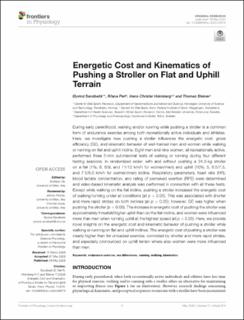| dc.description.abstract | During early parenthood, walking and/or running while pushing a stroller is a common form of endurance exercise among both recreationally active individuals and athletes. Here, we investigate how pushing a stroller influences the energetic cost, gross efficiency (GE), and kinematic behavior of well-trained men and women while walking or running on flat and uphill incline. Eight men and nine women, all recreationally active, performed three 5-min submaximal tests of walking or running during four different testing sessions, in randomized order: with and without pushing a 24.3-kg stroller on a flat (1%; 6, 8/9, and 11/12 km/h for women/men) and uphill (10%; 5, 6.5/7.5, and 7.5/8.5 km/h for women/men) incline. Respiratory parameters, heart rate (HR), blood lactate concentration, and rating of perceived exertion (RPE) were determined and video-based kinematic analysis was performed in connection with all these tests. Except while walking on the flat incline, pushing a stroller increased the energetic cost of walking/running under all conditions (all p < 0.05). This was associated with shorter and more rapid strides on both inclines (all p < 0.05); however, GE was higher when pushing the stroller (p < 0.05). The increase in energetic cost of pushing the stroller was approximately threefold higher uphill than on the flat incline, and women were influenced more than men when running uphill at the highest speed (all p < 0.05). Here, we provide novel insights on the energetic cost and kinematic behavior of pushing a stroller while walking or running on flat and uphill inclines. The energetic cost of pushing a stroller was clearly higher than for unloaded exercise, coincided by shorter and more rapid strides, and especially pronounced on uphill terrain where also women were more influenced than men. | en_US |
| dc.description.localcode | © 2020 Sandbakk, Perl, Holmberg and Steiner. This is an open-access article distributed under the terms of the Creative Commons Attribution License (CC BY). The use, distribution or reproduction in other forums is permitted, provided the original author(s) and the copyright owner(s) are credited and that the original publication in this journal is cited, in accordance with accepted academic practice. No use, distribution or reproduction is permitted which does not comply with these terms. | en_US |

